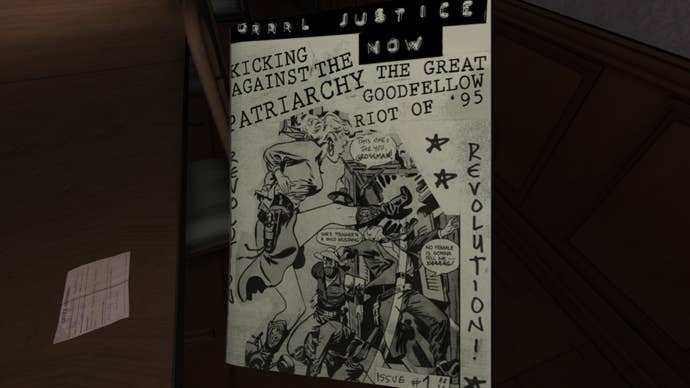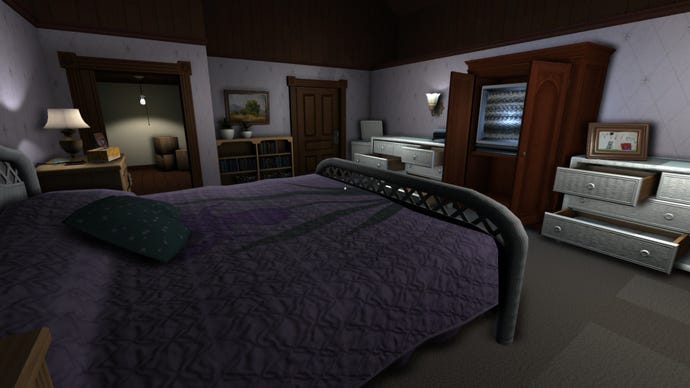Gone Home Review
This ol' house was home and comfort as we fought the storms of life.
This article first appeared on USgamer, a partner publication of VG247. Some content, such as this article, has been migrated to VG247 for posterity after USgamer's closure - but it has not been edited or further vetted by the VG247 team.
Have you ever come home to an empty house -- one that you know should be full of life, but which is strangely silent? It can be an unnerving experience.
Back in 2010, my wife and I decided to part ways. In order to make the "transition" easier, I went elsewhere for a few days while she moved all her possessions out. When I returned to my apartment, now gutted of any sign she'd ever been there, it was chilling. I went silently from room to room, just looking to see if there was anything she'd left behind -- but I knew it was hopeless, and I didn't know what I was expecting to find. In a daze and not sure what I was supposed to be feeling, I still searched every room, sometimes attributing meaning to things where there was none, and despite knowing my efforts wouldn't achieve anything.
When I eventually plucked up the courage to open the bedroom door, I found the bed we'd once shared perfectly made, and a pair of stuffed animals I'd bought her just sitting in the middle, accompanied by a handwritten note. I was instantly filled with a flood of emotions -- relief that she hadn't just immediately forgotten me upon walking out of the door; sadness that our time together had ended; anger that there was nothing I could do to prevent it or "fix" the situation.
I mention this experience not to be self-indulgent, but because I imagine it's very similar to what Gone Home's protagonist goes through. And the fact that I can empathize with these feelings to such a degree is one of the reasons I found Gone Home such an effective game.

In Gone Home, you take on the role of Katie, a 20 year old woman returning to her family after a year travelling around Europe. Her family has moved house in the intervening year, which means she's coming home to a house she doesn't know -- a clever framing device that helps account for the fact that you, the player, won't know where anything is. Neither does Katie!
After arriving on the front porch, Katie discovers two things: firstly, that the front door is locked and no-one seems to be home, and secondly, that there's a note from her sister Sam taped to the door. Sam, it seems, has gone away somewhere, and urges Katie not to go looking for her or to figure out what happened to her. Naturally, your job from hereon is to go looking for her and figure out what happened to her.
Gone Home is a game about slow, careful, systematic exploration and discovery. As you navigate Katie around her new family home, you can interact with almost anything -- pick up things from shelves and look at them, open drawers, turn lights on and off -- in your attempts to determine where your family is and what happened in the last year. To explain too much about the sort of things you'll find would be to spoil a significant part of the experience as a whole, but suffice to say the game's narrative unfolds in a number of ways -- through objects in the environment; through letters, notes and crumpled scraps of paper in wastebaskets; and, in the case of Sam, through spoken journal entries written to Katie, occasionally triggered by finding important items.
Despite its initial setup, Gone Home actually tells several different stories. As you creep through the house, you uncover details not only about Sam's situation, but also about what has been going on with Katie's parents, too. Sam's tale is clearly given the spotlight, as she's the only character who has a voice (besides an initial voiceover from Katie in the intro), but that doesn't make these other parallel narratives any less interesting to explore. In fact, I'd argue that the more subtle environmental storytelling of the non-Sam narratives is actually more effective than the somewhat linear-feeling progression of Sam's story. In the case of Sam's tale, you come across items in a logical order that tell her story roughly chronologically, and you always know when you've made progress because you get a new journal entry; in the others, it's determined by how hard you search the various rooms, what items you find and how thoroughly you examine them.

The progression of Sam's tale can, in fact, feel jarringly "gamey" at times thanks to locked doors and secret passageways only becoming accessible when the game's good and ready for you to go through them, but it seems that the team at Fullbright was ready for this criticism: a "Modifiers" menu when you start a new game allows you to tailor the experience in several different ways, including starting with all the locked doors unlocked, meaning you can discover the story at your own pace in whatever order you like. I wouldn't go so far as to say either way is the "right" way to go about experiencing the game's story for yourself, but it's nice to have the option, along with a few other possible tweaks. (As an aside, a thousand thank-yous to Fullbright for not including achievements in this game; they'd have utterly ruined the sense of discovery.)
The actual stories are interesting and provide sufficient impetus to continue playing, even if they're all a little predictable in nature at times. It's also quite easy to accidentally leave the "side stories" unresolved by the time you reach the end of Sam's tale, which ends the game -- though it does allow you to resume from just before the action that triggers the credits if you want to go back and explore more, which is nice. One thing that is rather nice about all the narrative threads, however, particularly in Sam's case, is that there's a certain degree of ambiguity and being open to interpretation -- at least until you learn the truth for yourself. Going in to the game "blind" without knowing any details about the story is very much a benefit here, as you then get the intriguing enjoyment of trying to figure out just what kind of story it's trying to tell with limited information.
Katie is also left as something of a blank slate, allowing the player to project themselves onto her easily; you're left, for the most part, to interpret things according to your own values as opposed to those the writers decided Katie should have -- probably a sensible approach. There's one instance later in the game where Katie refuses to look at something she doesn't want to read; this is initially jarring given her seeming lack of personality and player-independent agency for the rest of the time you're seeing life through her eyes, but the game handles this quite well: you get just enough time to glance over the item and get the gist of it without being able to take in the details. There's also the odd Easter egg in the interface; while the button prompts on screen are mostly of the cold, clinical nature ("grab cup," "open door"), occasionally Katie won't be able to resist commenting on something. I'll leave those for you to discover, though.

Is Gone Home a masterpiece? No. It's relatively easy to see the twists and turns in the various narratives coming well before they happen, and the subject matter, while encouragingly mature and sensitively handled, could have delved much deeper into the issues it's exploring. It's also too easy to rush through the game and leave all the threads except Sam's story left dangling in a distinctly unsatisfying manner -- though if this happens it's probably more a fault of the player than the design of the game itself, and it's difficult to know how this could be resolved without more explicit signposting spoiling the game's inherent sense of discovery.
Is Gone Home an important game, though? Absolutely. It's a great example of one of the many ways in which the inherent interactivity of the video game medium can be used to tell a story without spoon-feeding information to the player. Its combination of both explicit and implicit narrative cues sets a great example for others to follow in the future, and makes the prospect of games with a larger scope designed around similar principles rather exciting. Its unconventional, non-violent subject matter and gameplay also skilfully and confidently prove that not all games need an "attack" button to be enjoyable and interesting -- and given the growing sense of weariness a lot of us have been feeling with super-violent experiences, that's something that should be celebrated.
The Nitty Gritty
- Visuals: The house is well-rendered and atmospherically lit -- though it sometimes feels as if the "just moved in" motif was used as an excuse to leave some rooms a little barren.
- Music: Chris Remo's ambient score complements the story beats perfectly, while the cassette tapes featuring bands such as Heavens to Betsy and Bratmobile help evoke a real sense of the game's '90s setting.
- Interface: Simple and easy to navigate with either mouse and keyboard or controller, Gone Home ensures that its controls don't get in the way of the unfolding story.
- Lasting Appeal: Your first playthrough will be somewhere in the region of 2-3 hours. Will you return to it? Probably not -- at least not immediately -- but it's worth sharing with others; particularly those who perhaps aren't as "into" games, but who would appreciate the story.
ConclusionGone Home's non-violent, narrative-heavy experience won't be to everyone's taste, but engage with it -- preferably in a single sitting -- and you'll find yourself drawn deeply into an incredibly immersive experience.








